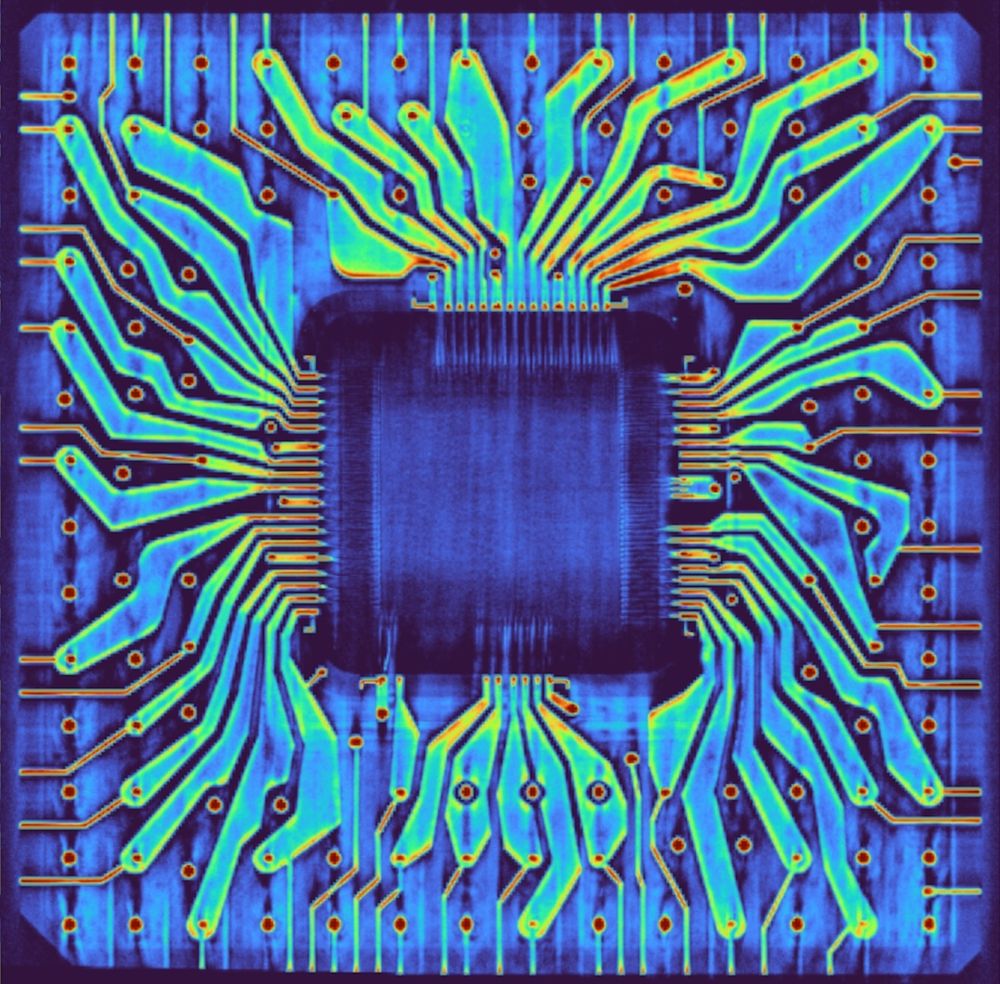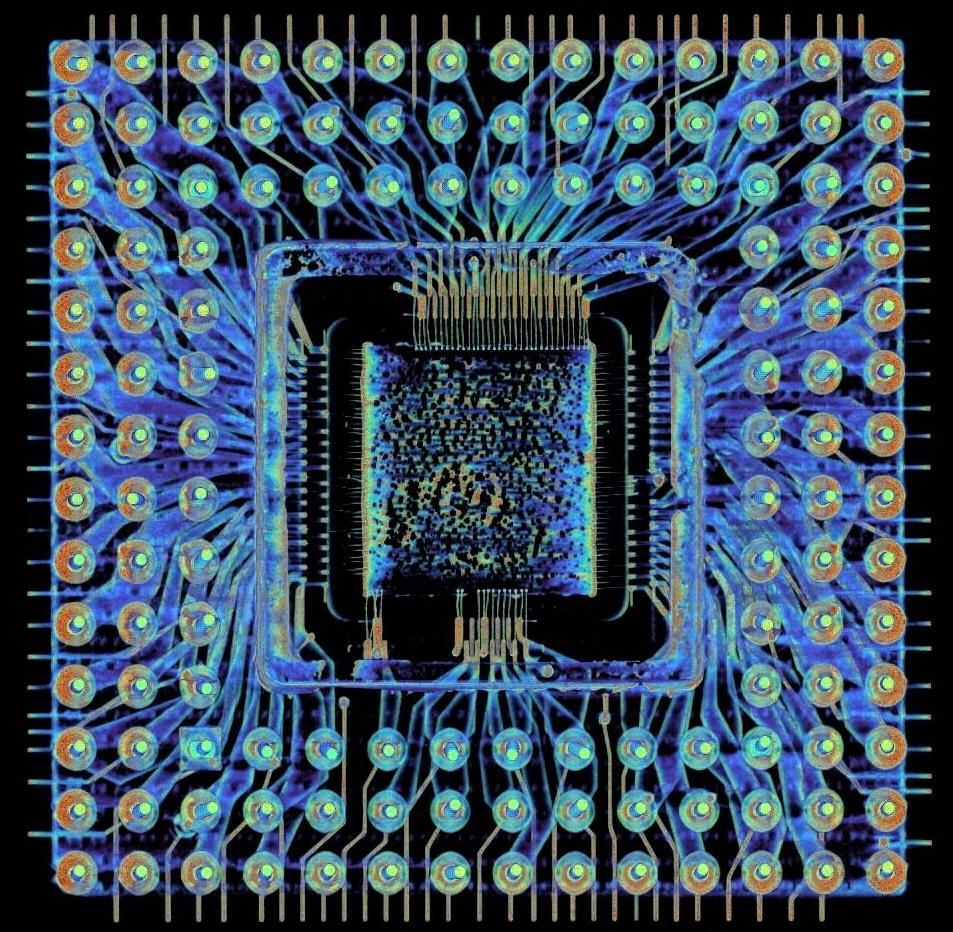
Ken Shirriff
@righto.com
Computer history. Reverse-engineering old chips. Restored Apollo Guidance Computer, Alto. Ex-Google, Sun, Msft. So-called boffin.
MiniZinc gave me a solution to the Pips puzzle in 100 milliseconds. Admittedly, this puzzle is rated "easy", but MiniZinc quickly solves hard puzzles too. Internally, MiniZinc uses complicated algorithms such as backjumping and constraint propagation, but I don't need to worry about that.


October 18, 2025 at 4:20 PM
MiniZinc gave me a solution to the Pips puzzle in 100 milliseconds. Admittedly, this puzzle is rated "easy", but MiniZinc quickly solves hard puzzles too. Internally, MiniZinc uses complicated algorithms such as backjumping and constraint propagation, but I don't need to worry about that.
I used a constraint solver called MiniZinc. I wrote constraints for the problem: the conditions on the grid, the shape of the grid, and the values of the dominoes. A few more constraints defined how the problem works. I didn't need to write algorithms because MiniZinc solves automatically.

![Code:
constraint pips[1,1] + pips[2,1] == 8;
constraint pips[2,3] < 5;
constraint all_equal([pips[3,1], pips[3,2], pips[3,3]]);](https://cdn.bsky.app/img/feed_thumbnail/plain/did:plc:svh6dgjnpkdl4dhxahj4xvkv/bafkreidkdyzpspryzvkwiacmfwmdywyyi6tdvyuris2rcohcc3ippainke@jpeg)
![Code:
grid = [|
1,1,0|
1,1,1|
1,1,1|];](https://cdn.bsky.app/img/feed_thumbnail/plain/did:plc:svh6dgjnpkdl4dhxahj4xvkv/bafkreids7pl26yehzdsfkmavx74xxoc7hl2hnj6hwdt452hlyss467qiy4@jpeg)
![Code:
spots = [|5,1| 1,4| 4,2| 1,3|];](https://cdn.bsky.app/img/feed_thumbnail/plain/did:plc:svh6dgjnpkdl4dhxahj4xvkv/bafkreibmqg5qucjsi6su3g55hyaqh6u5cvsmjetfmb3hxktz2x5f3evu5m@jpeg)
October 18, 2025 at 4:20 PM
I used a constraint solver called MiniZinc. I wrote constraints for the problem: the conditions on the grid, the shape of the grid, and the values of the dominoes. A few more constraints defined how the problem works. I didn't need to write algorithms because MiniZinc solves automatically.
The New York Times recently introduced daily puzzles called Pips. You place the dominoes on the grid so the numbers satisfy the labels.
I solved Pips with cool software called a constraint solver. You give the constraints, e.g. "sum to 8", and it "magically" finds a solution. Let's look closer...
I solved Pips with cool software called a constraint solver. You give the constraints, e.g. "sum to 8", and it "magically" finds a solution. Let's look closer...

October 18, 2025 at 4:20 PM
The New York Times recently introduced daily puzzles called Pips. You place the dominoes on the grid so the numbers satisfy the labels.
I solved Pips with cool software called a constraint solver. You give the constraints, e.g. "sum to 8", and it "magically" finds a solution. Let's look closer...
I solved Pips with cool software called a constraint solver. You give the constraints, e.g. "sum to 8", and it "magically" finds a solution. Let's look closer...
The hammers looked okay, but @tubetime.bsky.social found that hammer #83 was sticky. He cleaned it and then the printer worked, just in time for the demo. (Stop by the museum on Wednesdays or Saturdays to see the system in operation.) Photo shows a hammer from an earlier repair.

October 2, 2025 at 9:54 PM
The hammers looked okay, but @tubetime.bsky.social found that hammer #83 was sticky. He cleaned it and then the printer worked, just in time for the demo. (Stop by the museum on Wednesdays or Saturdays to see the system in operation.) Photo shows a hammer from an earlier repair.
We took the hammer unit out of the printer. Fortunately, IBM designed the printer for (relatively) easy maintenance. Inside the printer are two rails that can be attached to the back. The hammer unit slides out and tilts for access. You can see some hammers and coils; more are underneath.


October 2, 2025 at 9:54 PM
We took the hammer unit out of the printer. Fortunately, IBM designed the printer for (relatively) easy maintenance. Inside the printer are two rails that can be attached to the back. The hammer unit slides out and tilts for access. You can see some hammers and coils; more are underneath.
The line printer uses a chain with raised characters that spins at high speed. It has 132 hammers, one for each column. When the right character on the chain is in front of a hammer, the hammer fires, printing that character. But if a hammer fails, that column doesn't print, as you can see. 2/N


October 2, 2025 at 9:54 PM
The line printer uses a chain with raised characters that spins at high speed. It has 132 hammers, one for each column. When the right character on the chain is in front of a hammer, the hammer fires, printing that character. But if a hammer fails, that column doesn't print, as you can see. 2/N
We fixed the vintage IBM printer at the Computer History Museum yesterday. Introduced in 1959, the IBM 1403 line printer provided fast, high-quality output, printing 132 character lines. Unfortunately, one column stopped printing, so we disassembled the printer to fix a bad hammer. Keep reading...

October 2, 2025 at 9:54 PM
We fixed the vintage IBM printer at the Computer History Museum yesterday. Introduced in 1959, the IBM 1403 line printer provided fast, high-quality output, printing 132 character lines. Unfortunately, one column stopped printing, so we disassembled the printer to fix a bad hammer. Keep reading...
The iPhone 17 is powered by Apple's A19 SoC (System on a Chip). Chipwise took a die photo of the chip, but it's a bit drab. I spiced it up by applying the over-saturated color gradient that Apple used for die photos of the M1 chip :-)
Link to the original die photo: chipwise.tech/our-portfoli...
Link to the original die photo: chipwise.tech/our-portfoli...

September 23, 2025 at 11:39 PM
The iPhone 17 is powered by Apple's A19 SoC (System on a Chip). Chipwise took a die photo of the chip, but it's a bit drab. I spiced it up by applying the over-saturated color gradient that Apple used for die photos of the M1 chip :-)
Link to the original die photo: chipwise.tech/our-portfoli...
Link to the original die photo: chipwise.tech/our-portfoli...
Marilou Schultz first made a chip rug in 1994, when Intel commissioned a rug based on the Pentium as a gift to AISES (American Indian Science & Engineering Society). The Pentium weaving used natural dyes, while the 555 weaving uses aniline dyes and some metallic threads for more intense colors.

September 6, 2025 at 3:25 PM
Marilou Schultz first made a chip rug in 1994, when Intel commissioned a rug based on the Pentium as a gift to AISES (American Indian Science & Engineering Society). The Pentium weaving used natural dyes, while the 555 weaving uses aniline dyes and some metallic threads for more intense colors.
Marilou Schultz based the rug on a photo by Antoine Bercovici (Siliconinsider). He used a special dark field microscope that produces a black background, highlighting the metal wiring on top of the silicon. The rug (left) mostly matches the photo (right), but there are some artistic changes.

September 6, 2025 at 3:25 PM
Marilou Schultz based the rug on a photo by Antoine Bercovici (Siliconinsider). He used a special dark field microscope that produces a black background, highlighting the metal wiring on top of the silicon. The rug (left) mostly matches the photo (right), but there are some artistic changes.
Here's a photo of the silicon die of the 555 chip—it's packaged in a metal can, rather than usual plastic rectangle, with 8 pins in a circle. If you zoom way in, you can see the pattern on the silicon matches the rug, in particular, the three large squares with a 王 pattern.

September 6, 2025 at 3:25 PM
Here's a photo of the silicon die of the 555 chip—it's packaged in a metal can, rather than usual plastic rectangle, with 8 pins in a circle. If you zoom way in, you can see the pattern on the silicon matches the rug, in particular, the three large squares with a 王 pattern.
Celebrated Navajo (Diné) artist Marilou Schultz recently completed a striking weaving. Although this rug may appear abstract, it is a representation of the wiring inside an integrated circuit. It shows the 555 timer, said at one point to be the world's most popular IC. Let's take a closer look...

September 6, 2025 at 3:25 PM
Celebrated Navajo (Diné) artist Marilou Schultz recently completed a striking weaving. Although this rug may appear abstract, it is a representation of the wiring inside an integrated circuit. It shows the 555 timer, said at one point to be the world's most popular IC. Let's take a closer look...
The latest issue of @science.org mentions a magnetic compound Cr2Gr2Te6. The element Gr confused me, but it turned out to be a typo for Ge, germanium. Strangely, I found multiple papers with the same typo in the same context, so I wrote a short blog post about it.
www.righto.com/2025/08/Cr2G...
www.righto.com/2025/08/Cr2G...

August 18, 2025 at 6:47 PM
The latest issue of @science.org mentions a magnetic compound Cr2Gr2Te6. The element Gr confused me, but it turned out to be a typo for Ge, germanium. Strangely, I found multiple papers with the same typo in the same context, so I wrote a short blog post about it.
www.righto.com/2025/08/Cr2G...
www.righto.com/2025/08/Cr2G...
The 386 uses a complicated circuit, based on a memory chip's "sense amplifier" to reduce metastability. The sense amplifier speeds up the decision between 0 and 1. This circuit is relatively large, so only a few pins need it, inputs with unpredictable timings.


August 17, 2025 at 2:45 PM
The 386 uses a complicated circuit, based on a memory chip's "sense amplifier" to reduce metastability. The sense amplifier speeds up the decision between 0 and 1. This circuit is relatively large, so only a few pins need it, inputs with unpredictable timings.
The third danger facing a chip is "metastability". If a signal arrives at just the wrong time, the circuit can get stuck between 0 and 1 for a while before deciding on 0 or 1. This causes wrong results. It's like a ball wobbling on top of a hill, eventually rolling down one side or the other.


August 17, 2025 at 2:45 PM
The third danger facing a chip is "metastability". If a signal arrives at just the wrong time, the circuit can get stuck between 0 and 1 for a while before deciding on 0 or 1. This causes wrong results. It's like a ball wobbling on top of a hill, eventually rolling down one side or the other.
The second danger facing a chip is "latchup": if the voltage on a pin is out of range, unwanted "parasitic" transistors can turn on, shorting power to ground and burning out the chip. Special "guard rings" around the I/O transistors block unwanted currents to prevent latchup.

August 17, 2025 at 2:45 PM
The second danger facing a chip is "latchup": if the voltage on a pin is out of range, unwanted "parasitic" transistors can turn on, shorting power to ground and burning out the chip. Special "guard rings" around the I/O transistors block unwanted currents to prevent latchup.
Static electricity is a danger to chips. The tiny transistors inside a chip use thin layers of glass-like silicon dioxide, just 250 nm thick, thinner than a virus. Static electricity can easily blow a hole through this layer, destroying the chip. Special diodes redirect static electricity safely.

August 17, 2025 at 2:45 PM
Static electricity is a danger to chips. The tiny transistors inside a chip use thin layers of glass-like silicon dioxide, just 250 nm thick, thinner than a virus. Static electricity can easily blow a hole through this layer, destroying the chip. Special diodes redirect static electricity safely.
How did Intel's 386 processor connect to the outside world? Tiny wires connect to the bond pads around the edges. Special input/output circuits—visible in zoomed-in blocks—send and receive signals while protecting the chip from dangers that could destroy it. Let's take a look... 1/N

August 17, 2025 at 2:45 PM
How did Intel's 386 processor connect to the outside world? Tiny wires connect to the bond pads around the edges. Special input/output circuits—visible in zoomed-in blocks—send and receive signals while protecting the chip from dangers that could destroy it. Let's take a look... 1/N
I found an integrated circuit with tiny Chinese-style tally marks in the upper right corner. The chip was built by Integrated Device Technology (IDT) in 1991; IDT was an American company, so I don't know why the tally marks are Chinese.


August 9, 2025 at 8:19 PM
I found an integrated circuit with tiny Chinese-style tally marks in the upper right corner. The chip was built by Integrated Device Technology (IDT) in 1991; IDT was an American company, so I don't know why the tally marks are Chinese.
Here are the remaining four layers inside the package: one signal layer and three power layers. There are four power layers altogether so the chip's I/O circuitry and logic circuitry can be powered separately. That way, current surges from I/O don't affect the CPU.




August 9, 2025 at 4:40 PM
Here are the remaining four layers inside the package: one signal layer and three power layers. There are four power layers altogether so the chip's I/O circuitry and logic circuitry can be powered separately. That way, current surges from I/O don't affect the CPU.
One of the six power layers inside the Intel 386 processor's packaging. It's almost a solid conductive plane; the grid of holes joins the ceramic above and below. Most of the pins are connected to lower layers, so only a few pins (red dots) reach this layer.

August 9, 2025 at 4:40 PM
One of the six power layers inside the Intel 386 processor's packaging. It's almost a solid conductive plane; the grid of holes joins the ceramic above and below. Most of the pins are connected to lower layers, so only a few pins (red dots) reach this layer.
The CT scan of a signal layer inside the 386's package. The wide abstract-looking regions connect the pins (red dots) to the chip in the middle. Unexpectedly, I spotted thin wires running to the edges of the chip. These are used during manufacturing to electroplate the pins with gold.

August 9, 2025 at 4:40 PM
The CT scan of a signal layer inside the 386's package. The wide abstract-looking regions connect the pins (red dots) to the chip in the middle. Unexpectedly, I spotted thin wires running to the edges of the chip. These are used during manufacturing to electroplate the pins with gold.
The silicon die of the 386 processor is mounted in the middle of the ceramic package. Tiny bond wires connect the die to two tiers of contacts that surround it. Intricate but hidden wiring inside the ceramic connects these contacts to the 132 gold-plated pins. 2/N


August 9, 2025 at 4:40 PM
The silicon die of the 386 processor is mounted in the middle of the ceramic package. Tiny bond wires connect the die to two tiers of contacts that surround it. Intricate but hidden wiring inside the ceramic connects these contacts to the 132 gold-plated pins. 2/N
Intel's 386 processor was popular in late 1980s microcomputers. From the outside, the 386 chip is a boring ceramic square. But I obtained a 3-dimensional CT X-ray scan from Lumafield, revealing six layers of complex wiring hidden inside the ceramic package. Let's take a closer look... 1/N

August 9, 2025 at 4:40 PM
Intel's 386 processor was popular in late 1980s microcomputers. From the outside, the 386 chip is a boring ceramic square. But I obtained a 3-dimensional CT X-ray scan from Lumafield, revealing six layers of complex wiring hidden inside the ceramic package. Let's take a closer look... 1/N
A diagram with more details. It's a 7-stage shift register, but only the first four stages are bonded to pins, so a 4-stage shift register, unless there's feedback. I think data is bottom left and clk is bottom right. I'm suspicious of the first flip-flop output; I don't see the wire I expected.

August 8, 2025 at 2:51 AM
A diagram with more details. It's a 7-stage shift register, but only the first four stages are bonded to pins, so a 4-stage shift register, unless there's feedback. I think data is bottom left and clk is bottom right. I'm suspicious of the first flip-flop output; I don't see the wire I expected.

